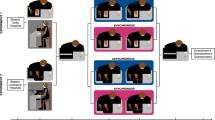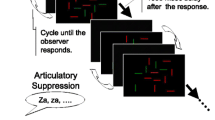Abstract
Four experiments addressed the role of cast shadows of the body in orienting tactile spatial attention to the body itself. We used a modified spatial-cueing paradigm to examine whether viewing of the cast shadow of a hand can elicit spatial shifts of tactile attention to that very same hand. Participants performed a speeded tactile-discrimination task (thumb versus index finger, regardless of touched hand), while viewing the shadow of either the touched or untouched hand cast in front of them by a lateral light-source. The hand casting the shadow changed either between blocks (expt 1) or unpredictably within each block (expts 2–4). In experiments 1 and 2 tactile targets were preceded by central non-informative visual cues delivered near the shadow of the index finger and thumb. Despite the fact that cast shadows were always task-irrelevant and non-predictive of which hand was stimulated, tactile discrimination was consistently faster at the hand casting the shadow than at the other hand. This effect was not modulated by the duration of cue-target asynchrony, nor did it depend on whether the visual cue was present or not (expt 3). In addition, it was still reliable when vision of the hands was precluded, whereas it became inconsistent when the cast shadow of the hand was replaced by the cast shadow of an object (expt 4). Our results suggest that body shadows can induce a long-lasting capture of tactile attention for stimuli at the body itself.


Similar content being viewed by others
Notes
To examine whether validity effect changed across time during the object-shadow experimental blocks, we analysed the first and the second halves of each block separately. For simplicity (and also in consideration of a potential speed-accuracy trade-off in this data set) we calculated a combined measure of RTs and accuracy known as inverse efficiency (IE) as the mean RT divided by the proportion of trials correct (Spence et al. 2001; Townsend and Ashby 1983). Mean IE scores for each participant were submitted to an ANOVA with two within-participants factors: trials (first versus second halves) and Validity (valid versus invalid). This ANOVA revealed a two-way interaction [F(1,15)=5.506, MSe=896.229, P=0.03], caused by larger (and positive) validity effect for the trials belonging to second (mean=19, SE=9) than first halves of the object-shadow blocks (mean=−16, SE=10). This may constitute preliminary evidence that a validity effect for object-shadow can build up over time.
References
Astafiev SV, Stanley CM, Shulman GL, Corbetta M (2004) Extrastriate body area in human occipital cortex responds to the performance of motor actions. Nat Neurosci 7:542–548
Bonfiglioli C, Pavani F, Castiello U (2004) Differential effects of cast shadows on perception and action. Perception 33:1291–1304
Castiello U (2001) Implicit processing of shadows. Vision Res 41:2305–2309
Castiello U, Lusher D, Burton C, Disler P (2003) Shadows in the brain. J Cogn Neurosci 15:862–872
Cheal ML, Lyon DR (1991) Central and peripheral precuing of forced-choice discrimination. Q J Exp Psychol 43A:859–880
Downing PE, Jiang J, Shuman M, Kanwisher N (2001) A cortical area selective for visual processing of the human body. Science 293:2470–2473
Farnè A, Ladavas E (2000) Dynamic size-change of hand peripersonal space following tool use. Neuroreport 11:1645–1649
Friesen CK, Kingstone A (1998) The eyes have it! Reflexive orienting is triggered by nonpredictive cue gaze. Psychon Bull Rev 5:490–495
Friesen CK, Kingstone A (2003) Abrupt onsets and gaze direction cues trigger independent reflexive attentional effects. Cognition 87:B1–B10
Gallagher S (2000) Philosophical conceptions of the self: implications for cognitive science. Trends Cogn Sci 4:14–21
George N, Driver J, Dolan RJ (2001) Seen gaze-direction modulates fusiform activity and its coupling with other brain areas during face processing. Neuroimage 13:1102–1112
Haggard P, Taylor-Clarke M, Kennett S (2003) Tactile perception, cortical representation and the bodily self. Curr Biol 13:170–173
Hietanen JK (2002) Social attention orienting integrates visual information from head and body orientation. Psychol Res 66:174–179
Holmes NP, Calvert GA, Spence C (2004) Extending or projecting peripersonal space with tools? Multisensory interactions highlight only the distal and proximal ends of tools. Neurosci Lett 372:62–67
Kanwisher N, McDermott J, Chun M (1997) The fusiform face area: a module in human extrastriate cortex specialized for the perception of faces. J Neurosci 17:4302–4311
Kennett S, Taylor-Clarke M, Haggard P (2001) Noninformative vision improves the spatial resolution of touch in humans. Curr Biol 11:1188–1191
Kersten D, Knill DC, Mamassian P, Bulthoff I (1996) Illusory motion from shadows. Nature 379:31
Kersten D, Mamassian P, Knill DC (1997) Moving cast shadows induce apparent motion in depth. Perception 26:171–192
Kingstone A, Smilek D, Ristic J, Friesen CK, Eastwood JD (2003) Attention, researchers! It is time to take a look at the real world. Curr Dir Psychol Sci 12:176–180
Klein RM (2000) Inhibition of return. Trends Cogn Sci 4:138–147
Langton SRH (2000) The mutual influence of gaze and head orientation in the analysis of social attention direction. Q J Exp Psychol 53A:825–845
Lupiáñez J, Milan EG, Tornay FJ, Madrid E, Tudela P (1997) Does IOR occur in discrimination tasks? Yes, it does, but later. Percept Psychophys 59:1241–1254
Mamassian P, Knill DC, Kersten D (1998) The perception of cast shadows. Trends Cogn Sci 2:288–295
Maravita A, Husain M, Clarke K, Driver J (2001) Reaching with a tool extends visuo-tactile interactions into far space: evidence from cross-modal extinction. Neuropsychologia 39:580–585
Maravita A, Spence C, Kennett S, Driver J (2002) Tool-use changes multimodal spatial interactions between vision and touch in normal humans. Cognition 83:B25–B34
Pavani F, Castiello U (2004) Binding personal and extrapersonal space through body shadows. Nat Neurosci 7:13–14
Pavani F, Spence C, Driver J (2000) Visual capture of touch: out-of-the-body experiences with rubber gloves. Psychol Sci 11:353–359
Posner MI, Cohen Y (1984) Components of visual orienting. In: Bouma H, Bouwhuis DG (eds) Attention and performance X. Erlbaum, Hillsdale, N.J., pp 531–556
Sanders AF (1975) The foreperiod effect revisited. Q J Exp Psychol 27A:591–598
Spence C, McGlone F (2001) Reflexive spatial orienting of tactile attention. Exp Brain Res 141:324–330
Spence C, Nicholls MER, Gillespie N, Driver J (1998) Cross-modal links in exogenous covert spatial orienting between touch, audition, and vision. Percept Psychophys 60:544–557
Spence C, Lloyd D, McGlone F, Nicholls MER, Driver J (2000) Inhibition of return is supramodal: a demonstration between all possible pairings of vision, touch, and audition. Exp Brain Res 134:42–48
Spence C, Kettenmann B, Kobal G, McGlone FP (2001) Shared attentional resources for processing visual and chemosensory information. Q J Exp Psychol 54A:775–783
Spence C, Pavani F, Driver J (2004) Spatial constraints on visual-tactile cross-modal distractor congruency effects. Cogn Affect Behav Neurosci 4:148–169
Tassinari G, Campara D (1996) Consequences of covert orienting to non-informative stimuli of different modalities: A unitary mechanism? Neuropsychologia 34:235–245
Townsend JT, Ashby FG (1983) The stochastical modeling of elementary psychological processes. Cambridge University Press, Cambridge
Turatto M, Benso F, Galfano G, Umiltà C (2002) Nonspatial attentional shifts between audition and vision. J Exp Psychol Hum Percept Perform 28:628–639
Turatto M, Galfano G, Bridgeman B, Umiltà C (2004) Space-independent modality-driven attentional capture in auditory, tactile and visual systems. Exp Brain Res 155:301–310
Yantis S (1993) Stimulus-driven attentional capture and attentional control settings. J Exp Psychol Hum Percept Perform 19:676–681
Yonas A, Goldsmith LT, Hallstrom JL (1978) Development of sensitivity to information provided by cast shadows in pictures. Perception 7:333–341
Acknowledgements
We are grateful to Giuliano Miotto for technical support, to Maurizio Dal Bosco and Claudia Bonfiglioli for help with artwork, and to Gianluca Godino for help with data collection. We also thank Nicholas Holmes, Salvador Soto-Faraco, and an anonymous reviewer for their excellent comments on a previous draft.
Author information
Authors and Affiliations
Corresponding author
Additional information
Preliminary results of this study were reported at the Fifth Annual Meeting of the International Multisensory Research Forum (Sitges, Spain), June 2004.
Rights and permissions
About this article
Cite this article
Galfano, G., Pavani, F. Long-lasting capture of tactile attention by body shadows. Exp Brain Res 166, 518–527 (2005). https://doi.org/10.1007/s00221-005-2392-9
Received:
Accepted:
Published:
Issue Date:
DOI: https://doi.org/10.1007/s00221-005-2392-9




